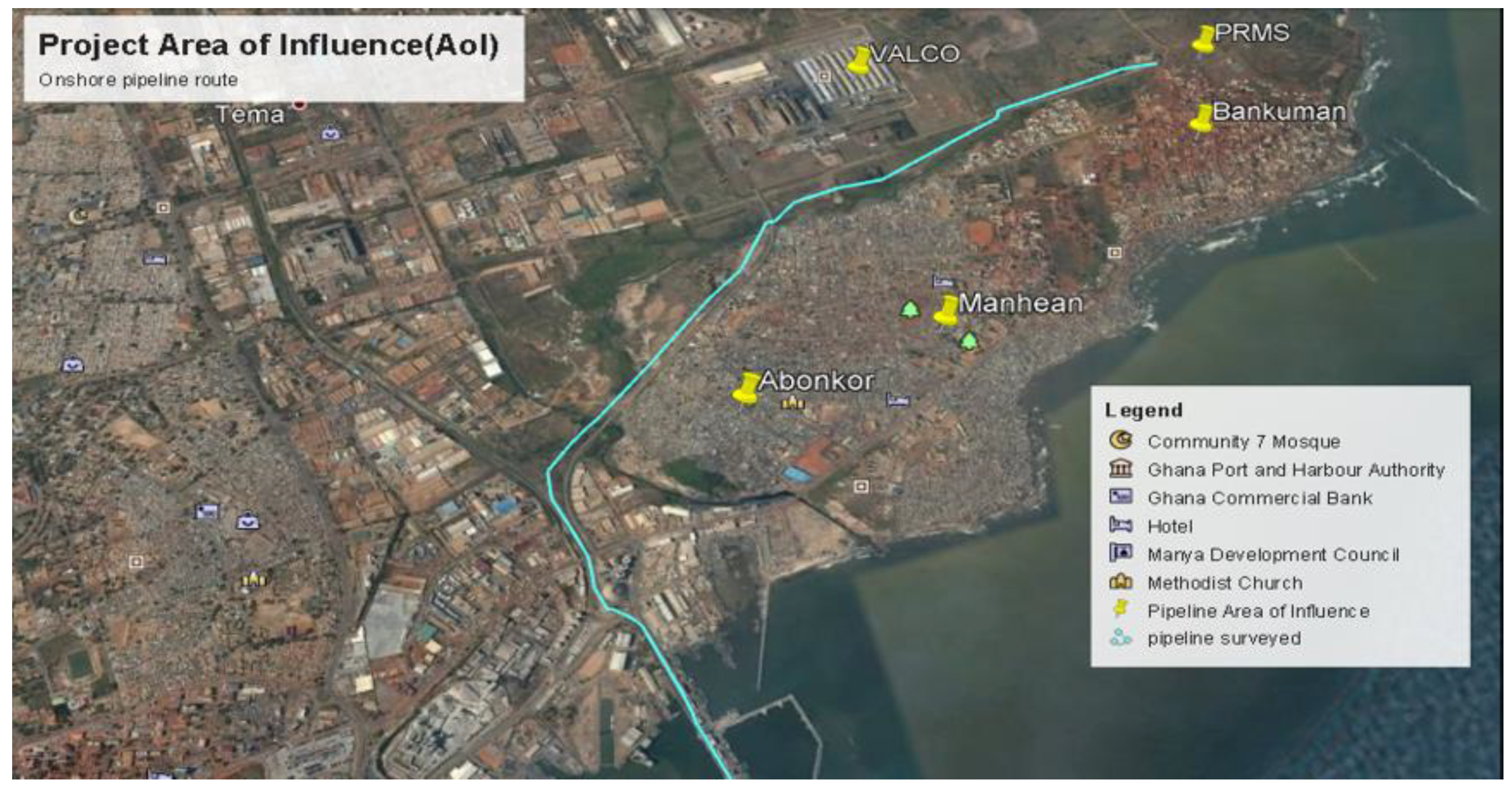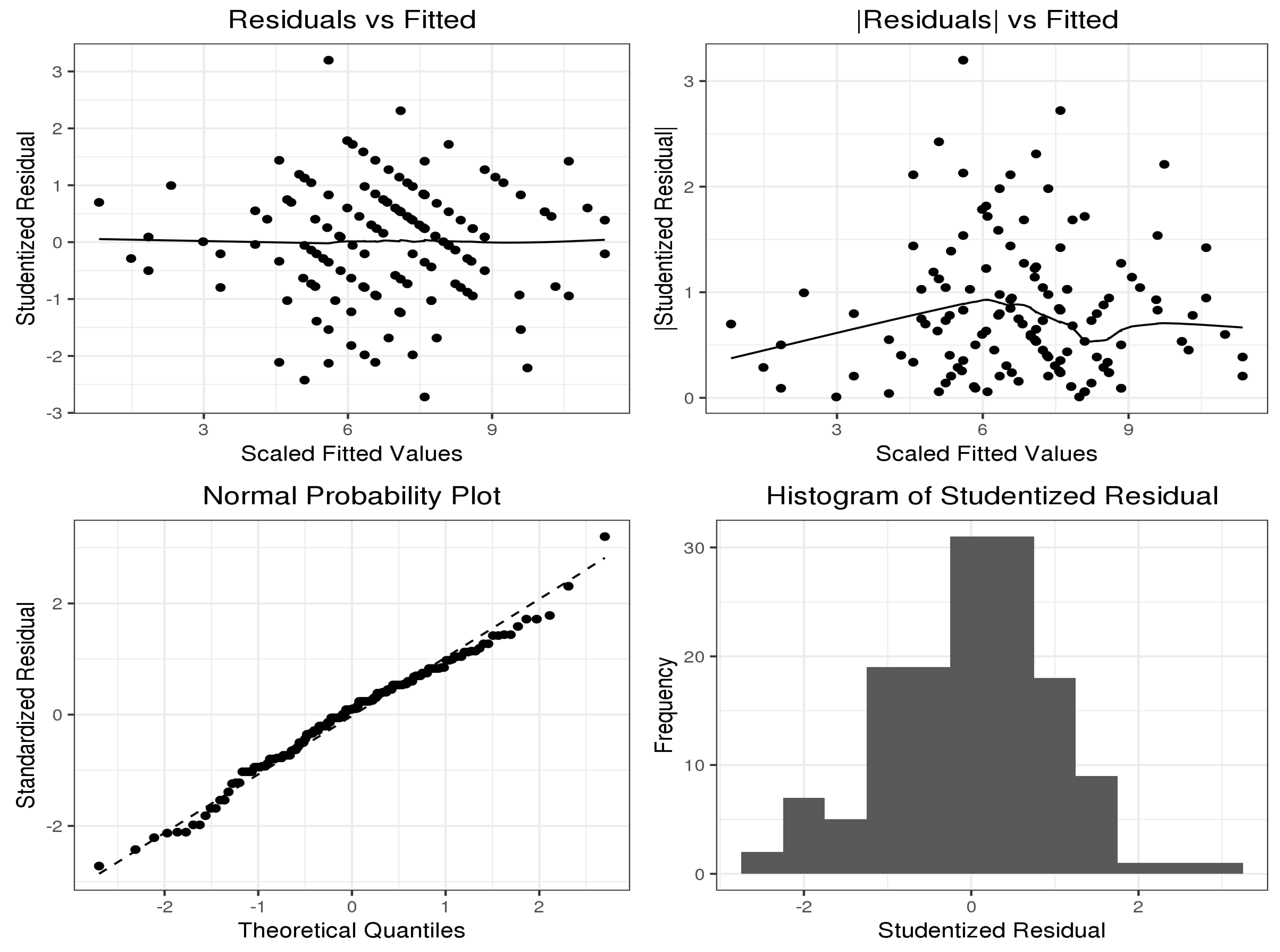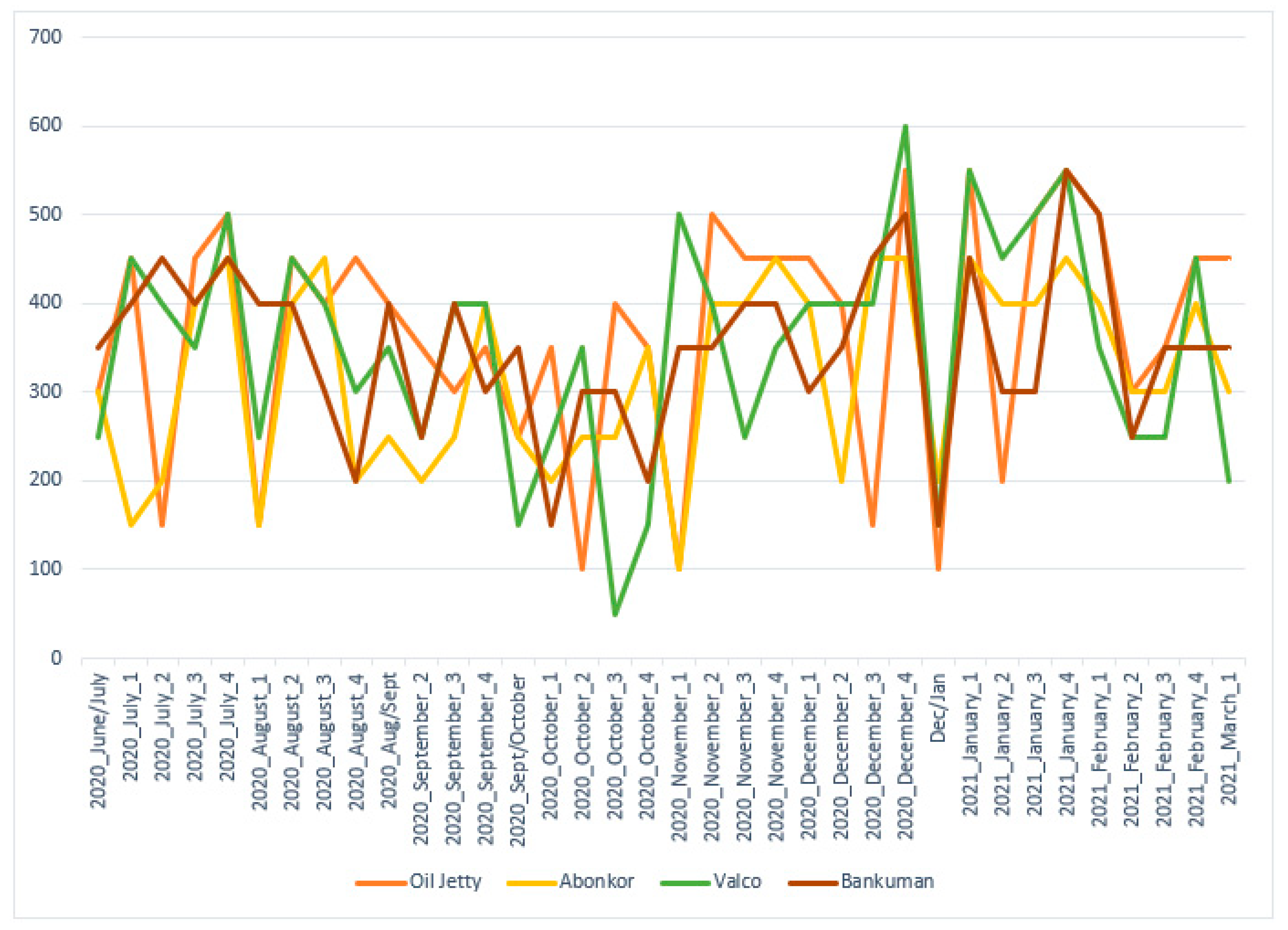Understanding NO2 Concentration Dynamics within Tema Metropolitan Area of Ghana Using Generalized Linear Model
Abstract
1. Introduction
2. Materials and Methods
2.1. Study Area
2.2. Measurement of NO2
2.3. Statistical Analysis
3. Results
3.1. NO2 Concentration across the Four (4) Locations
3.2. Differences between Baseline and Study Period NO2 Concentration Levels
3.3. Model for NO2 Concentration
4. Discussion
5. Conclusions
Author Contributions
Funding
Institutional Review Board Statement
Informed Consent Statement
Data Availability Statement
Acknowledgments
Conflicts of Interest
References
- Lee, D.-H.; An, S.-S.; Song, H.-M.; Park, O.-H.; Park, K.-S.; Seo, G.-Y.; Cho, Y.-G.; Kim, E.-S. The effect of traffic volume on the air quality at monitoring sites in Gwangju. Korean Soc. Environ. Health 2014, 40, 204–214. [Google Scholar] [CrossRef][Green Version]
- Borge, R.; Santiago, J.L.; Paz, D.; de la Martin, F.; Domingo, J.; Valdes, C.; Sanchez, B.; Rivas, E.; Rozas, M.T.; Lazaro, S.; et al. Application of a short-term air quality action plan in Madrid (Spain) under a high-pollution episode-part II: Assessment from multi-scale modelling. Sci. Total Environ. 2018, 635, 1574–1584. [Google Scholar] [CrossRef]
- Valks, P.; Pinardi, A.; Richter, A.; Lambert, J.-C.; Hao, N.; Loyola, D.; van Roozendael, M.; Emmadi, S. Operational total and tropospheric NO2 column retrieval for GOME-2. Atmos. Meas. Technol. 2011, 4, 1491–1514. [Google Scholar] [CrossRef]
- Hamra, G.B.; Laden, F.; Cohen, A.J.; Raaschou-Nielsen, O.; Brauer, M.; Loomis, D. Lung cancer and exposure to nitrogen dioxide and traffic: A systematic review and meta-analysis. Environ. Health Perspect. 2015, 123, 1107–1112. [Google Scholar] [CrossRef]
- Kim, D.S.; Hwang, J.J. The origination mechanism of PM10 and methodology of identification for PM10 sources. Air Clean. Technol. 2002, 15, 38–53. [Google Scholar]
- Kim, Y.S.; Moon, J.S. A study on the relationship between air pollution and respiratory mortality. Atmos. Health Assoc. 1997, 23, 137–145. [Google Scholar]
- Seo, W.H.; Chang, S.S.; Kwon, H.J. Concentration of air pollutants and asthma in Taejon city. J. Environ. Health Sci. 2000, 26, 80–90. [Google Scholar]
- Curtis, L.; Rea, W.; Smith-Willis, P.; Fenyves, E.; Pan, Y. Adverse health effects of outdoor air pollutants. Environ. Int. 2006, 32, 815–830. [Google Scholar] [CrossRef]
- Hoek, G.; Meliefste, K.; Cyrys, J.; Lewné, M.; Bellander, T.; Brauer, M.; Fischer, P.; Gehring, U.; Heinrich, J.; van Vliet, P.; et al. Spatial variability of fine particle concentrations in three European areas. Atmos. Environ. 2002, 36, 4077–4088. [Google Scholar] [CrossRef]
- Henschel, S.; Atkinson, R.; Zeka, A.; Le Tertre, A.; Analitis, A.; Katsouyanni, K.; Chanel, O.; Pascal, M.; Forsberg, B.; Medina, S.; et al. Air pollution interventions and their impact on public health. Int. J. Public Health 2012, 57, 757–768. [Google Scholar] [CrossRef]
- Künzli, N.; Kaiser, R.; Medina, S.; Studnicka, M.; Chanel, O.; Filliger, P.; Herry, M.; Horak, F.; Puybonnieux-Texier, V.; Quénel, P.; et al. Public-health impact of outdoor and traffic-related air pollution: A European assessment. Lancet 2000, 356, 795–801. [Google Scholar] [CrossRef]
- Pope, C.A.; Burnett, R.T.; Turner, M.C.; Cohen, A.; Krewski, D.; Jerrett, M.; Gapstur, S.M.; Thun, M.J. Lung cancer and cardiovascular disease mortality associated with ambient air pollution and cigarette smoke: Shape of the exposure–response relationships. Environ. Health Perspect. 2011, 119, 1616–1621. [Google Scholar] [CrossRef]
- Conti, S.; Harari, S.; Caminati, A.; Zanobetti, A.; Schwartz, J.D.; Bertazzi, P.A.; Cesana, G.; Madotto, F. The association between air pollution and the incidence of idiopathic pulmonary fibrosis in Northern Italy. Eur. Respir. J. 2018, 51, 1700397. [Google Scholar] [CrossRef]
- European Commission. Communication from the Commission to the European Parliament, the Council, the European Economic and Social Committee and the Committee of the Regions ‘A Europe that Protects: Clean Air for All’. 2018. Available online: http://ec.europa.eu/environment/air/pdf/clean_air_for_all.pdf (accessed on 29 April 2021).
- Wang, Y.; Bechle, M.J.; Kim, S.-Y.; Adams, P.J.; Pandis, S.N.; Pope, C.A.; Robinson, A.L.; Sheppard, L.; Szpiro, A.A.; Marshall, J.D. Spatial decomposition analysis of NO2 and PM2.5 air pollution in the United States. Atmos. Environ. 2020, 241, 117470. [Google Scholar] [CrossRef]
- Shiohara, N.; Fernández-Bremauntz, A.A.; Jiménez, S.B.; Yanagisawa, Y. The commuters’ exposure to volatile chemicals and carcinogenic risk in Mexico City. Atmos. Environ. 2005, 39, 3481–3489. [Google Scholar] [CrossRef]
- Hoek, G.; Beelen, R.; De Hoogh, K.; Vienneau, D.; Gulliver, J.; Fischer, P.; Briggs, D. A review of land-use regression models to assess spatial variation of outdoor air pollution. Atmos. Environ. 2008, 42, 7561–7578. [Google Scholar] [CrossRef]
- Parra, M.A.; Elustondo, D.; Bermejo, R.; Santamaria, J.M. Ambient air levels of volatile organic compounds (VOC) and nitrogen dioxide (NO2) in a medium size city in Northern Spain. Sci. Total Environ. 2009, 407, 999–1009. [Google Scholar] [CrossRef]
- Han, X.; Naeher, L.P. A review of traffic-related air pollution exposure assessment studies in the developing world. Environ. Int. 2006, 32, 106–120. [Google Scholar] [CrossRef]
- Sarpong, S.; Donkoh, R.; Konnuba, J.; Ohene-Agyei, C.; Lee, Y. Analysis of PM2.5, PM10, and total suspended particle exposure in the tema metropolitan area of Ghana. Atmosphere 2021, 12, 700. [Google Scholar] [CrossRef]
- Ghaffarpasand, O.; Nadi, S.; Shalamzari, Z.D. Short-term effects of anthropogenic/natural activities on the Tehran criteria air pollutants: Source apportionment and spatiotemporal variation. Build. Environ. 2020, 186, 107298. [Google Scholar] [CrossRef]
- Ghana EPA. Annual Report 2015. Retrieved from Accra. 2016. Available online: http://www.epa.gov.gh/epa/sites/default/files/downloads/publications/2015%20Annual%20Report.pdf (accessed on 28 June 2021).
- IFC. Environmental, Health, and Safety General Guidelines. International Finance Corporation. 2007. Available online: https://www.ifc.org/wps/wcm/connect/topics_ext_content/ifc_external_corporate_site/sustainability-at-ifc/publications/publications_policy_ehs-general (accessed on 28 June 2021).
- Miller, P. IFC performance standards. In Proceedings of the SPE International Health, Safety & Environment Conference, Abu Dhabi, United Arab Emirates, 2–4 April 2006. [Google Scholar]
- Lee, Y.; Nelder, J.A. Double hierarchical generalized linear models (with discussion). J. R. Stat. Soc. Ser. C Appl. Stat. 2006, 55, 139–185. [Google Scholar] [CrossRef]
- Sarpong, S.A.; Sarpong, A.K.; Lee, Y. A Model for determining predictors of the MUAC in acute malnutrition in Ghana. Int. J. Environ. Res. Public Health 2021, 18, 3792. [Google Scholar] [CrossRef]
- Sarpong, S.A.; Avuglah, R.K.; Nsowah-Nuamah, N.N.N. Application of Joint generalized linear models in determining physical support factors that influence crop yield in Northern Ghana. Univers. J. Agric. Res. 2020, 8, 124–130. [Google Scholar] [CrossRef]
- Ryu, J.; Park, C.; Jeon, S.W. Mapping and statistical analysis of NO2 concentration for local government air quality regulation. Sustainability 2019, 11, 3809. [Google Scholar] [CrossRef]
- Rahman, A.; Luo, C.; Khan, M.H.R.; Ke, J.; Thilakanayaka, V.; Kumar, S. Influence of atmospheric PM2.5, PM10, O3, CO, NO2, SO2, and meteorological factors on the concentration of airborne pollen in Guangzhou, China. Atmos. Environ. 2019, 212, 290–304. [Google Scholar] [CrossRef]
- Xie, M.; Piedrahita, R.; Dutton, S.J.; Milford, J.B.; Hemann, J.G.; Peel, J.L.; Miller, S.L.; Kim, S.Y.; Vedal, S.; Sheppards, L.; et al. Positive matrix factorization of a 32-month series of daily PM2.5 speciation data with incorporation of temperature stratification. Atmos. Environ. 2013, 65, 11–20. [Google Scholar] [CrossRef][Green Version]
- Itahashi, S.; Uno, I.; Irie, H.; Kurokawa, J.-I.; Ohara, T. Regional modeling of tropospheric NO2 vertical column density over East Asia during the period 2000–2010: Comparison with multisatellite observations. Atmos. Chem. Phys. 2014, 14, 3623–3635. [Google Scholar] [CrossRef]
- Meng, X.; Chen, L.; Cai, J.; Zou, B.; Wu, C.-F.; Fu, Q.; Zhang, Y.; Liu, Y.; Kan, H. A land use regression model for estimating the NO2 concentration in Shanghai, China. Environ. Res. 2015, 137, 308–315. [Google Scholar] [CrossRef]
- Hatzopoulou, M.; Valois, M.F.; Mihele, C.; Lu, G.; Bagg, S.; Minet, L.; Brook, J. Robustness of land-use regression models developed from mobile air pollutant measurements. Environ. Sci. Technol. 2017, 51, 3938–3947. [Google Scholar] [CrossRef]
- Rho, Y. Pattern analysis and mapping of urban air pollution using exposure time metric and mortality caused by cardiovascular and respiratory illnesses. J. Environ. Policy Adm. 2017, 25, 21–48. [Google Scholar]
- Choi, G.; Bell, M.L.; Lee, J.T. A study on modeling nitrogen dioxide concentrations using land-use regression and conventionally used exposure assessment methods. Environ. Res. Lett. 2017, 12, 044003. [Google Scholar] [CrossRef]



| Pollutant | Location | No Pollution | Pollution | Chi-Squared |
|---|---|---|---|---|
| NO2 (IFC) | Abonkor | 9 | 27 | 0.423 |
| Bankuman | 4 | 32 | ||
| Oil_Jetty | 5 | 31 | ||
| Valco_Hosp | 6 | 30 | ||
| Total | 24 | 120 | ||
| NO2 (GHA) | Abonkor | 3 | 33 | 0.663 |
| Bankuman | 2 | 34 | ||
| Oil_Jetty | 4 | 32 | ||
| Valco_Hosp | 5 | 31 | ||
| Total | 14 | 130 |
| Mean | N | Std. Deviation | Std. Error Mean | ||
|---|---|---|---|---|---|
| Pair 1 | NO2_Base | 76.489 | 140 | 8.5454 | 0.7222 |
| NO2 | 342.500 | 140 | 113.4681 | 9.5898 | |
| Paired Differences | t | df | Sig. (2-Tailed) | ||||||
|---|---|---|---|---|---|---|---|---|---|
| Mean | Std. Deviation | Std. Error Mean | 95% Confidence Interval of the Difference | ||||||
| Lower | Upper | ||||||||
| Pair 1 | NO2_Base-NO2 | −266.01 | 112.5889 | 9.5155 | −284.83 | −247.19 | −27.95 | 139 | 0.000 |
| Estimate | Std. Error | t Value | Pr(>|t|) | |
|---|---|---|---|---|
| (Intercept) | 6.31944 | 1.02979 | 6.13661 | 0.0000 |
| 4 December 2020 | 3.25 | 1.39922 | 2.32273 | 0.02212 |
| 4 July 2020 | −5.5 | 1.39922 | −3.93077 | 0.00015 |
| 4 January 2021 | 4 | 1.39922 | 2.85874 | 0.00513 |
| Dec/Jan | −4 | 1.39922 | −2.85874 | 0.00513 |
| Oil Jetty area | 1.02778 | 0.46641 | 2.20362 | 0.02974 |
| Valco Hospital area | 1.02778 | 0.46641 | 2.20362 | 0.02974 |
Publisher’s Note: MDPI stays neutral with regard to jurisdictional claims in published maps and institutional affiliations. |
© 2022 by the authors. Licensee MDPI, Basel, Switzerland. This article is an open access article distributed under the terms and conditions of the Creative Commons Attribution (CC BY) license (https://creativecommons.org/licenses/by/4.0/).
Share and Cite
Sarpong, S.A.; Donkoh, R.F.; Lee, Y. Understanding NO2 Concentration Dynamics within Tema Metropolitan Area of Ghana Using Generalized Linear Model. Atmosphere 2022, 13, 91. https://doi.org/10.3390/atmos13010091
Sarpong SA, Donkoh RF, Lee Y. Understanding NO2 Concentration Dynamics within Tema Metropolitan Area of Ghana Using Generalized Linear Model. Atmosphere. 2022; 13(1):91. https://doi.org/10.3390/atmos13010091
Chicago/Turabian StyleSarpong, Smart Asomaning, Racheal Fosu Donkoh, and Youngjo Lee. 2022. "Understanding NO2 Concentration Dynamics within Tema Metropolitan Area of Ghana Using Generalized Linear Model" Atmosphere 13, no. 1: 91. https://doi.org/10.3390/atmos13010091
APA StyleSarpong, S. A., Donkoh, R. F., & Lee, Y. (2022). Understanding NO2 Concentration Dynamics within Tema Metropolitan Area of Ghana Using Generalized Linear Model. Atmosphere, 13(1), 91. https://doi.org/10.3390/atmos13010091








